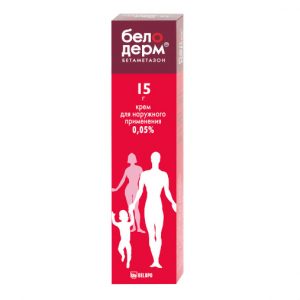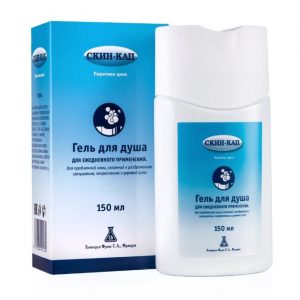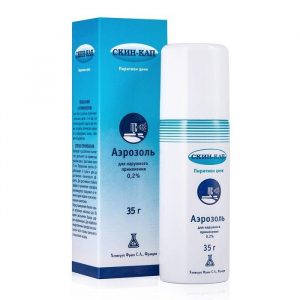Description
Release form
Cream for external use.
Packing
tube 25 g
Pharmacological action of
corticosteroids for external use.
Prevents marginal accumulation of neutrophils, reduces inflammatory exudation and production of lymphokines, inhibits macrophage migration, reduces the intensity of infiltration and granulation processes, and has local anti-inflammatory, antipruritic, anti-allergic antiexudative effects.
Indications
The drug Dermoveit is a highly active GCS for external use, which is indicated for use in adults, elderly people and children over the age of 1 year to alleviate the symptoms of inflammation and skin itching with dermatoses sensitive to GCS therapy.
Psoriasis (excluding common plaque psoriasis).
Eczema (various forms).
lichen planus.
Discoid lupus erythematosus.
Dermatoses resistant to therapy with less active corticosteroids for external use.
Contraindications
Bacterial, viral and fungal skin diseases (including herpes simplex, chickenpox, skin tuberculosis, actinomycosis).
Rosacea (Rosacea).
Acne.
skin cancer.
Hyde nodular pruritus.
Periodic dermatitis.
Itching in the absence of inflammation.
Perianal and genital itching.
Common plaque psoriasis.
Age to 1 year.
Lactation.
Hypersensitivity to the active substance and auxiliary components of the drug.
Caution: the drug should be used during pregnancy.
Use during pregnancy and lactation
GCS for external use should not be used during pregnancy in large doses for a long time. In studies, it was not found that the use of the drug during pregnancy has a negative effect on the health of a woman or a fetus.
The drug should be used during pregnancy only if the potential benefit to the mother outweighs the potential risk to the fetus.
The use of the drug during lactation is contraindicated.
Special instructions
Dermoveit should be used with caution in patients with a history of local hypersensitivity to GCS or to any of the excipients in the composition of the drug. Local hypersensitivity reactions may resemble the symptoms of an ongoing illness.
In some individuals, as a result of increased systemic absorption of GCS for external use, manifestations of hypercorticism (Cushing’s syndrome) and reversible inhibition of the hypothalamic-pituitary-adrenal system, leading to glucocorticosteroid insufficiency, may occur. If any of the above is observed, you should cancel the drug, gradually reducing the frequency of its application, or replace it with a less active GCS. Sudden cessation of treatment can lead to the development of glucocorticosteroid insufficiency.
Risk factors for enhancing systemic effects include the following: activity and dosage form of GCS for external use, duration of application, application of the drug to large areas of the skin, use in closed areas of the skin (i.e. in intertriginous areas or under occlusive dressings (diapers and diapers in babies can play the role of an occlusive dressing), increased hydration of the stratum corneum, use on areas with thin skin, such as a face, application to damaged skin or other conditions that may be accompanied by a violation skin barrier integrity.
Compared with adults, children and infants may have a higher percentage absorption of corticosteroids for external use, and therefore this category of patients is more at risk of developing systemic side effects. This is due to the fact that children have an immature skin barrier and a greater value of the ratio of body surface area to body weight compared to adults.
Use in children
The administration of corticosteroids for external use for a long time should be avoided, especially in the treatment of young children, since adrenal function may be inhibited. The use of the drug Dermoveit in children requires medical supervision at least 1 time per week. On the face more often than on other parts of the body, as a result of prolonged use of local GCS, atrophic changes in the skin can appear, which must be taken into account in the treatment of psoriasis, discoid lupus erythematosus and severe eczema with localization of rashes on the face.
Use for psoriasis
Treatment of psoriasis of corticosteroids for external use may be accompanied by a resumption of symptoms of the disease, drug resistance, the development of a generalized pustular form of psoriasis and local or systemic adverse reactions due to impaired barrier function of the skin, therefore, careful monitoring of the patient is especially important.
Concomitant
infection Appropriate antibacterial therapy should be given when a secondary infection is attached. With any signs of generalization of the infection, it is necessary to stop the external use of GCS and conduct appropriate treatment with antibacterial drugs.
Risk of developing an infection with occlusion
Warm, moist conditions created by applying an occlusive dressing contribute to bacterial infection, so be sure to thoroughly clean the skin before applying a new dressing.
Chronic leg ulcers
External glucocorticosteroids are sometimes used to treat dermatitis around chronic leg ulcers. However, such use may be accompanied by an increased incidence of local hypersensitivity reactions and an increased risk of developing local infections.
Application to the skin of the face
Application to the skin of the face is undesirable since this area is more susceptible to the development of atrophic changes. If applied to the face, treatment should be limited to a few days.
Application on the eyelids
When applying the cream on the eyelids, make sure that the drug does not get into the eyes, because repeated exposure to the cream can cause cataracts and glaucoma.
Influence on the ability to drive vehicles and operate machinery
No studies have been conducted on the effects of clobetasol on the ability to drive vehicles or operate machinery. Based on the profile of adverse reactions of clobetasol for external use, any adverse effect on such activities is not expected.
Composition 100 g of cream contain:
Active ingredient:
clobetasol propionate – 50 mg *.
Excipients:
glyceryl monostearate – 11 g,
propylene glycol glyceryl oleate (arlazel 165) – 1.5 g,
beeswax substitute 6621 – 1.25 g,
cetostearyl alcohol – 47 g,
, 8.4 g, 8.4 g,
5 g,
chlorocresol – 75 mg,
sodium citrate – 50 mg,
citric acid monohydrate – 50 mg,
purified water – up to 100 g
* – nominal amount of clobetasol propionate – 52.5 mg (taking into account 5% excess )
Dosage and Administration
Externally.
Application of the cream is especially advisable on wet or wet surfaces.
The cream is applied in a thin layer in an amount sufficient to cover the entire affected area, 1-2 times / day, gently rubbed. Duration of use – until the effect or, if necessary, up to 4 weeks.
If you want to continue treatment, it is recommended that you gradually reduce the frequency of application or switch to using a less active drug. Sufficient time should be provided for exposure after each application of Dermoveit before applying the emollient. For the treatment of exacerbations of skin diseases, repeated courses of Dermoveit are given.
In particularly resistant cases, especially in the presence of hyperkeratosis, the effect of Dermoveit cream for external use can be enhanced by applying an occlusive dressing overnight to the area of application, which is usually accompanied by a positive effect. In the future, the achieved effect can be maintained without the use of an occlusive dressing.
If the condition worsens or does not improve within 2-4 weeks, the diagnosis and treatment should be reviewed.
Maximum weekly dose should not exceed 50 g per week.
Atopic dermatitis (eczema)
Treatment with clobetasol should be gradually withdrawn immediately after achieving control of the disease, and emollient treatment should be continued as maintenance therapy.
Sudden withdrawal of clobetasol can lead to a relapse of previously existing dermatosis.
Eczema (various forms)
Patients with frequent relapses of the disease
In case of acute illness, as soon as the effect of a continuous course of external treatment for corticosteroids is achieved, the possibility of intermittent use (1 time / day, 2 times a week, without occlusal dressings). It is shown that such treatment effectively reduces the frequency of relapse.
Application of the drug should be continued on all previously affected areas of the skin or on known areas of potential exacerbation. This application should be combined with the daily routine use of emollients. A regular assessment should be made, and the benefits and risks of continuing treatment.
Special patient groups
Children
Children are more likely to develop local and systemic side effects with external therapy for corticosteroids and usually require shorter courses of treatment using less active agents than adults.
Caution should be exercised when using clobetasol in children to ensure that it is applied in a minimal amount that provides a therapeutic effect.
Elderly patients
Clinical studies have not revealed any differences in drug efficacy in elderly or younger patients. The high prevalence of decreased liver or kidney function in elderly patients can lead to a slowdown in the elimination of the drug in case of systemic absorption. Consequently, it should be used in elderly patients in a minimal amount and for the shortest possible period, but at the same time ensuring the achievement of the necessary clinical effect.
Patients with impaired renal and / or liver function
In the case of systemic absorption of the drug (when applied to large surfaces of the skin over an extended period), its metabolism and excretion may slow down, leading to an increased risk of developing systemic toxicity. Therefore, it should be used in such patients in a minimal amount and over the shortest possible period, while ensuring the achievement of the necessary clinical effect.
Side effects
Adverse events are listed below depending on the anatomical and physiological classification and frequency of occurrence. The frequency of occurrence is determined as follows:
Very often (? 1/10).
Often (? 1/100 and <1/10). Infrequently (? 1/1 000 and <1/100). Rarely (? 1/10 000 and <1/1 000). Very rare (<1/10 000, including isolated cases). Frequency categories were derived from clinical studies of the drug and post-registration observation. Infectious and parasitic diseases: very rarely – infection caused by opportunistic organisms. On the part of the immune system: very rarely – hypersensitivity. From the endocrine system: very rarely – inhibition of the hypothalamic-pituitary-adrenal system. Signs of a cushingoid (moon-shaped face, central obesity), delayed weight gain and / or growth retardation in children, osteoporosis, glaucoma, hyperglycemia and / or glucosuria, cataracts, hypertension, weight gain or obesity, decreased endogenous cortisol, alopecia brittle hair. From the skin and subcutaneous tissues: often – itching, burning sensation or soreness infrequently – local atrophy of the skin *, striae *, telangiectasia * very rarely – thinning *, wrinkling of the skin, dry skin *, change in pigmentation *, hypertrichosis, aggravation of the symptoms of the disease, allergic contact dermatitis, pustular psoriasis, erythema, rash, urticaria. * – skin manifestations are secondary to local and / or systemic effects of inhibition of the hypothalamic-pituitary-adrenal system. General disorders and disorders together with the introduction: very rarely – irritation and / or soreness at the site of application. When applied to large surfaces for a long period of time (for example, more than 2 weeks), patients may develop systemic side effects: gastritis, ulceration of the gastrointestinal mucosa, increased intraocular pressure, symptoms of hypercorticism. Drug Interactions It was shown that the simultaneous use of drugs that can inhibit the CYP3A4 isoenzyme (for example, ritonavir and itraconazole) inhibits the metabolism of corticosteroids, leading to an increase in their systemic exposure. The degree of clinical significance of this interaction depends on the dose and method of application of GCS and the activity of the inhibitor of the CYP3A4 isoenzyme. overdose Symptoms: Dermoveit, when used externally, may be absorbed in amounts sufficient to cause systemic effects. The development of an acute overdose is unlikely. However, symptoms of hypercorticism may develop in the event of a chronic overdose or misuse of the Dermoveit drug. Treatment: In case of overdose of the Dermoveit drug, the drug should be gradually discontinued, reducing the frequency of application or replacing less active ACS, under the supervision of a physician because of the risk of adrenal insufficiency. Further treatment should be carried out taking into account the clinical situation or in accordance with the recommendations of the toxicological centers, if any. Storage conditions Keep out of the reach and sight of children at temperatures not exceeding 30 ° C. Keep out of the reach and sight of children. Shelf life 2 years. dosage form cream Possible product names DERMOVEYT 0,5MG / G 25,0 CREAM DERMOVEYT 25G. CREAM Dermoveit cream 0.05% 25 g DERMOVE CREAM 0.05% 25G Dermoveit cream 0.05%, 25 g GlaxoSmithKline Pharmaceuticals SA, Poland




